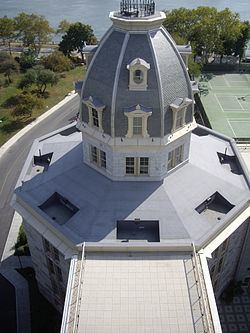Built 1835 Opened 1835 Added to NRHP 16 March 1972 | NRHP Reference # 72000880 Architectural style Octagon house | |
 | ||
Similar Roosevelt Island, Blackwell House, Blackwell Island Light, Chapel of the Good Shepherd, Smallpox Hospital | ||
The Octagon, built in 1834, is a historic octagonal building and attached apartment block complex located at 888 Main Street on Roosevelt Island in New York City. It originally served as the main entrance to the New York City Lunatic Asylum, which opened in 1841. Designed by Alexander Jackson Davis, the five-story rotunda was made of blue-gray stone that was quarried on the island. The Octagon is the last remnant of the hospital, and after many years of decay and two fires, was close to ruin. After restoration, it has now been incorporated into the adjacent buildings to create a large apartment complex.
Contents
History
Mistreatment of patients at the asylum was the center of the exposé by Nellie Bly in her 1887 book Ten Days in a Mad-House.
The Octagon was made part of the Metropolitan Hospital in 1894. The Octagon, as a Metropolitan Hospital building, closed in 1955, leaving the building abandoned. On March 16, 1972, despite its condition, it was added to the National Register of Historic Places.
After many years of decay, as well as two fires that nearly destroyed the building, the Octagon was renovated and turned into a residential building. In April 2006, the renovated Octagon reopened as the lobby entrance to a pair of adjacent apartment buildings with 500 units in total.
Sustainability
The new apartment complex utilizes both solar panels and fuel cell installations. A 50 kW array of solar panels and a 400 kW fuel cell enable the building to generate more than 50% of its power. The fuel cell is a combined heat and power system that converts natural gas to electricity and heat via a combustion-free, electrochemical process. This system provides power and heat that meets the majority of the building’s energy demand, and the efficiency it achieves is higher than the energy received from the power grid. Not only does the system provide more efficient energy usage, the heat from the process is also used for the building’s space heating and domestic water requirements. Thus the Octagon is projected to reduce its carbon emissions by 790 metric tons annually.
The Octagon received the largest initial award of New York State Green Building Tax Credits and was recognized in the first New York City Green Buildings Competition with the "Green Apple Award" for leadership in applying sustainable design principles to residential development. In 2006, a newly constructed residential building was built on the site, modeled on the original structure. It received LEED Silver status from the U.S. Green Building Council in 2008.
